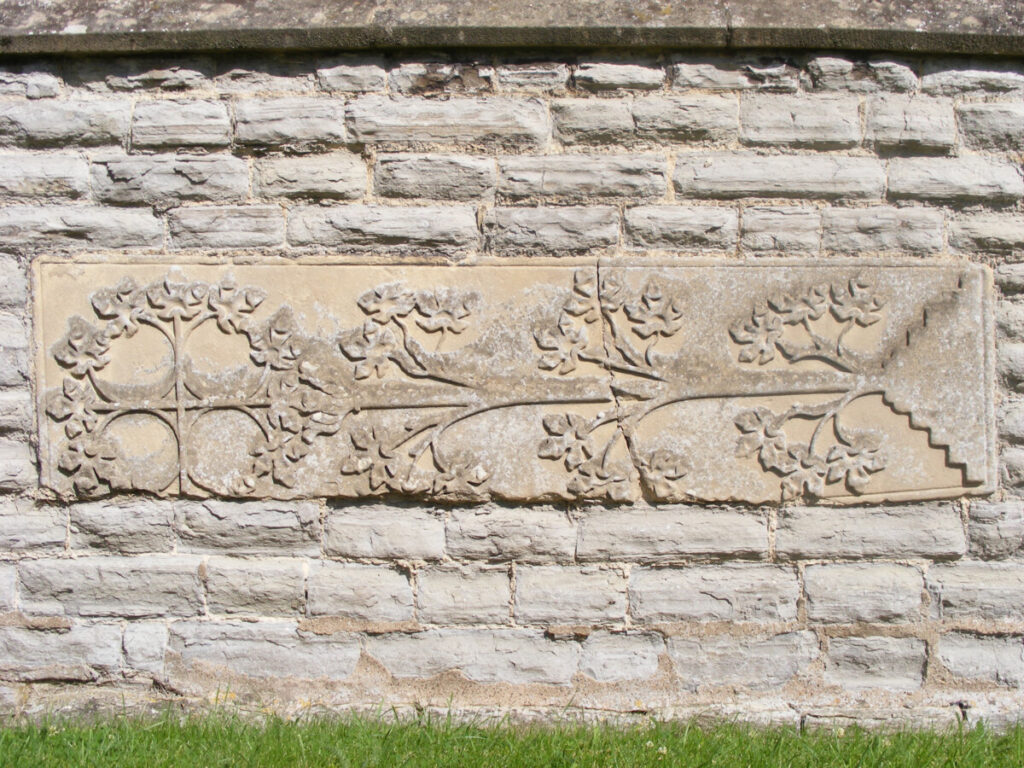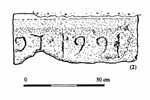The Tree of Life sculpture is a medieval cross slab, probably dating from the late C13th or early C14th. It is made of sandstone and has been set into the external west wall of the south aisle. Its origins are unknown and neither is it known when or where it was found or when it was set into its current position.
The name ‘cross slab’ refers to the Christian cross symbol found on these funerary markers; these were usually recumbent grave markers and have been found both inside and outside Church buildings. The term covers a wide range of styles and shapes but they were usually rectangular or tapered. The Hickling Tree of Life sculpture sits rather oddly in its horizontal setting; it is possible that it was originally a vertical/upright marker but it is more likely to have been recumbent, in which case the design would have been in its proper perspective when standing at the foot of the grave.
The symbolism and mythology of the Tree of Life crosses cultures, religions and centuries. In a Christian context, it is likely to refer back to the Biblical Book of Genesis and the Garden of Eden and links to the Tree of Knowledge.
The ‘Tree of Life’ features in creation myths across different cultures worldwide; in this context it has origins in Scandinavian/Viking mythology where the Norse universe is held together by a great tree, Yggdrasil. Maypoles have similar pagan origins with these ancient customs incorporated by the early Christian Church in to its calendar.
In 2014 Southwell Diocese and Skillington’s of Grantham (specialists in historic building repairs) carried out a risk assessment and outlined the risks of keeping the monument in its current position against the risks of moving it undercover (copy of this correspondence available for reference on request). It has certainly deteriorated in the meantime and its conservation/preservation is an expensive problem for the Church. The analysis carried out in 2014 explained:
- The cross-slab, is about late 13th century, early 14th century in origin and one of the finest in the county. There is a vertical crack through the stone [which pre-dates its setting into the wall] and evidence of deterioration through weathering, probably caused by water run-off from the wall.
- The slab has been trimmed along its lower edge. If dimensions are derived taking symmetry into account then the north edge of the slab has been truncated by a maximum of 170mm. Presumably this destruction was carried out on account of it fitting in easily with the regular courses of Blue Lias limestone by making the object square.
A second mediaeval cross-slab can be found in the Chancel on the opposite side of the aisle to the Anglo-Scandinavian hogback; much broader and more rectangular in shape, the design has deteriorated significantly. Sadly, little is known about this monument (see, ‘cross slab 3’, below).
Tree of Life & Medieval Cross Slabs
Southwell and Nottingham Church History Project.
- https://southwellchurches.nottingham.ac.uk/hickling/hintro.php
- https://southwellchurches.nottingham.ac.uk/hickling/harchlgy.php#asgravecover
(1) One of the finest cross slabs in Nottinghamshire is built into the external face of the west wall of the south aisle, set horizontally 0.50 m above the ground. It is a tapering slab, carved in bold relief on fine-grained fawn sandstone, with a roll-moulded edge. It is almost intact – the left edge has been trimmed slightly – and in surprisingly good condition, although a monument of this quality really should be taken inside.
The cross rises from a multi-stepped base and basically has four bracelets on a slender straight-arm cross, but the bracelet terminal and buds are all naturalistic five-lobed leaves, whilst three pairs of branches with similar foliage spring from the shaft. An extraordinarily accomplished piece of 14th century work that deserves to be better known.
(2) A fragment built into the small buttress to the east of the north door, 1.5 m above the ground. One chamfered edge is visible, and remains of what appear to be incused letters or numbers, which might be interpreted as the date ‘1661’ (inverted), so only doubtfully a medieval monument.
(3) Tapering slab, in two pieces, built into the external face of the east wall of the north aisle. A central incised cross shaft, quite broad, is discernible, with at its top a rectangular panel infilled with cement. Only the faintest traces remain of the cross head, which may have been of a four-circle or bracelet type.
Descriptions and drawings of the cross slabs courtesy of Peter Ryder.
Images – on website




